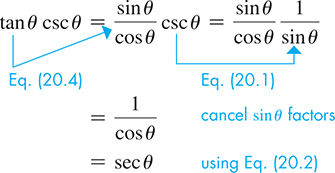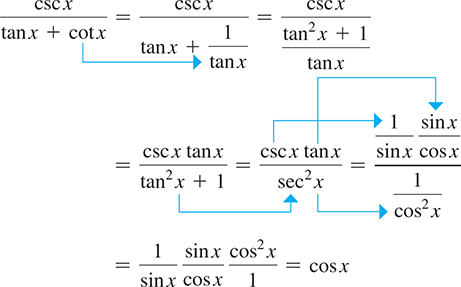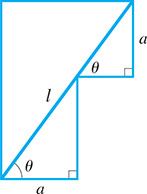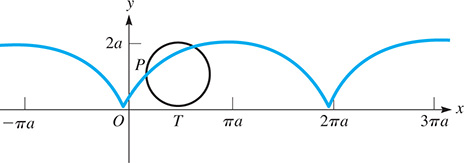20.1 Fundamental Trigonometric Identities
Trigonometric Identities • Basic Identities • Proving Trigonometric Identities
From the definitions in Chapters 4 and 8, recall that and (see Fig. 20.1). Because we see that These definitions hold for any angle, which means that is true for any angle. This type of relation, which is true for any value of the variable, is called an identity. Of course, values where division by zero would be indicated are excluded.

Fig. 20.1
In this section, we develop several important identities involving the trigonometric functions. We also show how the basic identities are used to verify other identities.
From the definitions, we have
Also, from the definitions and the Pythagorean theorem in the form of we arrive at the following identities.
By dividing the Pythagorean relation through by we have
By dividing the Pythagorean relation by we have
By dividing the Pythagorean relation by we have
BASIC IDENTITIES
NOTE
[The term is the common way of writing and it means to square the value of the cosine of the angle.]
Obviously, the same holds true for the other functions.
Summarizing these results, we have the following important identities.
In using the basic identities, may stand for any angle or number or expression representing an angle or a number.
EXAMPLE 1 Using basic identities
EXAMPLE 2 Checking identities with numerical values
Let us check the last two illustrations of Example 1 for the given values of
Using a calculator, we find that
We see that
Checking Example 1(c), refer to Fig. 20.2.

Fig. 20.2
We see that this checks with Eq. (20.6) for these values.
EXAMPLE 3 Simplifying basic expressions
Multiply and simplify the expression
Factor and simplify the expression
We see that when algebraic operations are performed on trigonometric terms, they are handled in just the same way as with algebraic terms. This is true for the basic operations of addition, subtraction, multiplication, and division, as well as other operations used in simplifying expressions, such as factoring or taking roots.
PROVING TRIGONOMETRIC IDENTITIES
A great many identities exist among the trigonometric functions. We are going to use the basic identities that have been developed in Eqs. (20.1) through (20.8), along with a few additional ones developed in later sections to prove the validity of still other identities.
CAUTION
The ability to prove trigonometric identities depends to a large extent on being very familiar with the basic identities so that you can recognize them in somewhat different forms.
If you do not learn these basic identities and learn them well, you will have difficulty in following the examples and doing the exercises. The more readily you recognize these forms, the more easily you will be able to prove such identities.
In proving identities, look for combinations that appear in, or are very similar to, those in the basic identities. This is illustrated in the following examples.
EXAMPLE 4 Proving a trig identity
In proving the identity
we know that Because sin x appears on the left, substituting for cot x on the right will eliminate cot x and introduce sin x. This should help us proceed in proving the identity. Thus, starting with the right-hand side, we have

By showing that the right side may be changed exactly to sin x, the expression on the left side, we have proved the identity.
Some important points should be made in relation to the proof of the identity of Example 4. We must recognize which basic identities may be useful. The proof of an identity requires the use of the basic algebraic operations, and these must be done carefully and correctly. Although in Example 4, we changed the right side to the form on the left, we could have changed the left to the form on the right. From this and the fact that various substitutions are possible, we see that a variety of procedures can be used to prove any given identity.
CAUTION
Performing the algebraic operations carefully and correctly is very important when working with trigonometric expressions. Operations such as substituting, factoring, and simplifying fractions are frequently used.
EXAMPLE 5 Trig identity—two different solutions
Prove that
In proving this identity, we know that and also that Thus, by substituting for we introduce in the denominator, which is equivalent to introducing in the numerator. Therefore, changing only the left side, we have

Having changed the left side into the form on the right side, we have proven the identity.
Many variations of the preceding steps are possible. We could have changed the right side to obtain the form on the left. For example,
In proving the identities in Examples 4 and 5, we showed that the expression on one side of the equal sign can be changed into the expression on the other side. Because we want to prove that the expressions are equal, we cannot transpose terms or multiply each side by the same quantity as we do when solving equations. Each side must be treated separately. In this way, we know the form we are attempting to attain, and by looking ahead, we are better able to make the necessary changes.
NOTE
[Although we could make changes to each side independently to hopefully arrive at the same expression, we will restrict the method of proof to changing only one side into the same form as the other side.]
There is no set procedure for working with identities. The most important factors are to (1) recognize the proper forms, (2) try to identify what effect a change may have before performing it, and (3) perform all steps correctly. If the forms are about the same, a first close look often suggests possible steps to use.
NOTE
[Normally, it is easier to change the form of the more complicated side to the same form as the less complicated side.]
EXAMPLE 6 Proving a trig identity
Prove the identity
Because the more complicated side is on the left, we will change the left side to tan y, the form on the right. Because we want tan y as the final form, we will use the basic identities to introduce tan y where possible. Thus, noting the cot y in the denominator, we substitute 1/tan y for cot y. This gives

In the form on the right we now note the factor of tan y in each term. Factoring tan y from each of these terms, and then using the basic identity in the form we can complete the proof. Therefore,

NOTE
[Note carefully that we had to use the identity in a somewhat different form from that shown in Eq. (20.7).]
The use of such variations in form to prove identities is a very common procedure.
EXAMPLE 7 Proving a trig identity
Prove the identity
The combination also suggests since multiplying by gives which can then be replaced by Thus, changing only the left side, we have

EXAMPLE 8 Trig identity—radiation rate of electric charge
In finding the radiation rate of an accelerated electric charge, it is necessary to show that Show this by changing the left side.
Because each term on the right has a factor of we see that we can proceed by writing as Then the factor and the on the right suggest the use of Eq. (20.6). Thus, we have

Because we substituted for we used Eq. (20.6) in the form
EXAMPLE 9 Simplifying a trig expression
Simplify the expression
We proceed with a simplification in a manner similar to proving an identity, although we do not know what the result should be. Following is one procedure for this simplification:

A calculator can be used to check an identity or a simplification. This is done by graphing the function on each side of an identity, or the initial expression and the final expression for simplification. If the two graphs are the same, the identity or simplification is probably shown to be correct, although this is not strictly a proof.
EXAMPLE 10 Trig identity—verifying by calculator
Use a calculator to verify the identity of Example 7.
Noting this identity as on a calculator, we let
We then graph these two functions as shown in Fig. 20.3. The screenshot shows (in red) in the process of being plotted right on top of (in blue). Because these curves are the same, the identity appears to be verified (although it has not been proven).

Fig. 20.3
Working with trigonometric identities has often been considered a difficult topic. However, as we emphasized earlier, knowing the basic identities very well and performing the necessary algebraic steps properly should make proving these identities a much easier task.
EXERCISES 20.1
In Exercises 1 and 2, make the given changes in the indicated examples of this section and then prove the resulting identities.
In Example 4, change the right side to tan x/sec x.
In Example 6, change the first term on the left to
In Exercises 3–6, use a calculator to check the indicated basic identities for the given angles.
Eq. (20.4) for
Eq. (20.5) for
Eq. (20.6) for
Eq. (20.7) for
In Exercises 7–12, multiply and simplify. In Exercises 13–18, factor and simplify.
In Exercises 19–38, prove the given identities.
In Exercises 39–46, simplify the given expressions. The result will be one of sin x, cos x, tan x, cot x, sec x, or csc x.
In Exercises 47–50, for a first-quadrant angle, express the first function listed in terms of the second function listed.
sin x, sec x
cos x, csc x
tan x, csc x
cot x, sec x
In Exercises 51–54, use a calculator to verify the given identities by comparing the graphs of each side.
In Exercises 55–58, use a calculator to determine whether the given equations are identities.
In Exercises 59–62, solve the given problems involving trigonometric identities.
When designing a solar-energy collector, it is necessary to account for the latitude and longitude of the location, the angle of the sun, and the angle of the collector. In doing this, the equation is used. If show that
In determining the path of least time between two points under certain conditions, it is necessary to show that
Show this by transforming the left-hand side.
Show that the length l of the straight brace shown in Fig. 20.4 can be found from the equation

Fig. 20.4
The path of a point on the circumference of a circle, such as a point on the rim of a bicycle wheel as it rolls along, tracks out a curve called a cycloid. See Fig. 20.5. To find the distance through which a point moves, it is necessary to simplify the expression Perform this simplification.

Fig. 20.5
In Exercises 63–70, solve the given problems.
 Explain how to transform into
Explain how to transform into  Explain how to transform into 1.
Explain how to transform into 1.Show that has a constant value.
Show that cot y csc y sec cos y cot y has a constant value.
If evaluate
If evaluate
Prove that by expressing each function in terms of its x, y, and r definition.
Prove that by expressing each function in terms of its x, y, and r definition.
In Exercises 71–74, use the given substitutions to show that the given equations are valid. In each,
If show that
If show that
If show that
If show that
Answers to Practice Exercises
tan x
